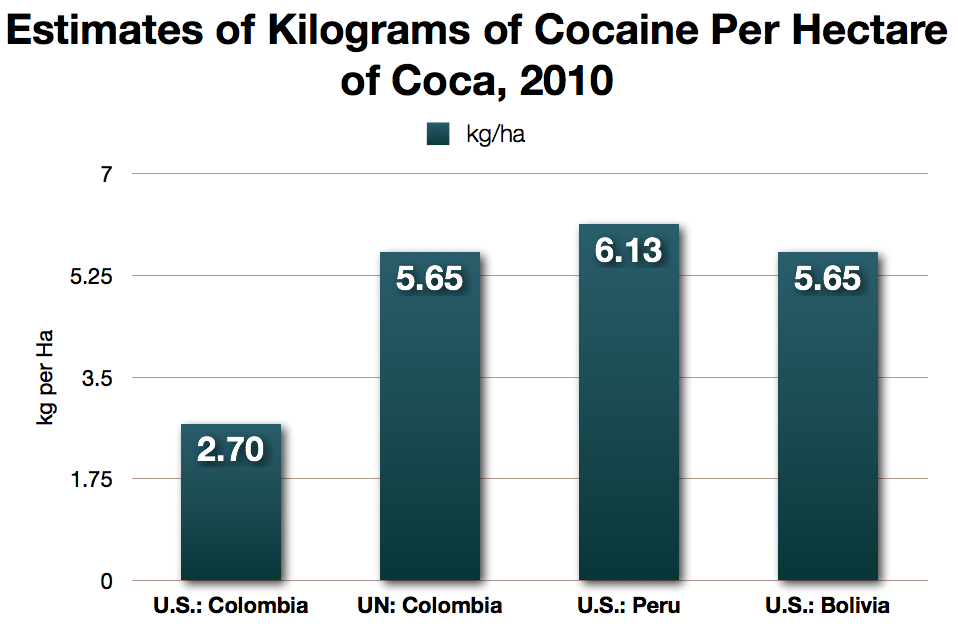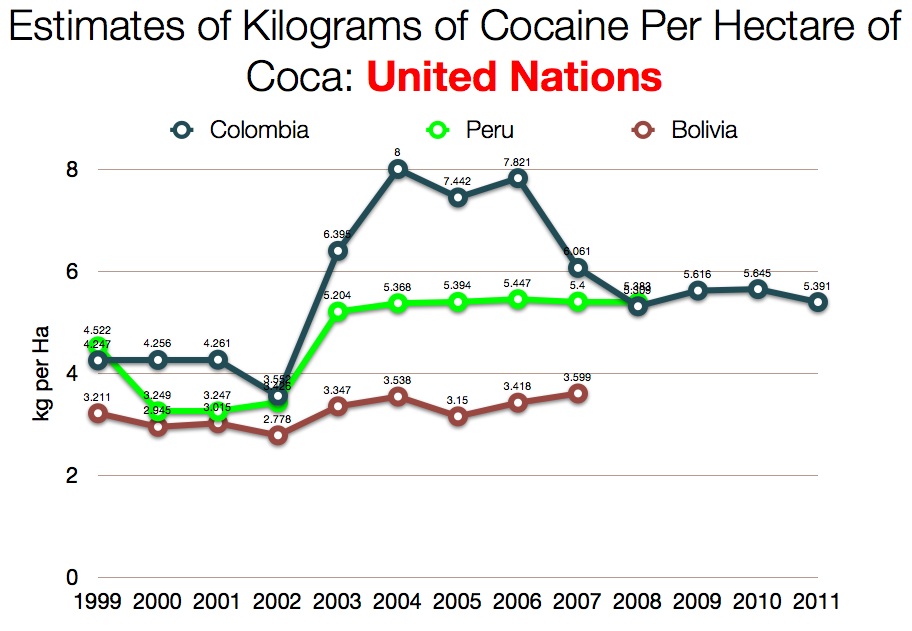El Washington Office on Latin America, WOLA, reveló recientemente las notorias contradicciones en los estimados de las Naciones Unidas y el gobierno de Estados Unidos sobre la producción de cocaína tanto total como por hectárea de coca en Colombia, Perú y Bolivia.
A continuación, algunas de las discrepancias señaladas en el informe titulado “UN and U.S. Estimates for Cocaine Production Contradict Each Other”.
- El miércoles 25 de julio, la UNODC (la oficina de las Naciones Unidas sobre drogas y criminalidad) publicó su último informe sobre el monitoreo de la superficie de hoja de coca en Colombia, con cifras de 2011.
- El documento indica que las hectáreas de cocales en Colombia aumentaron de 62,000 a 64,000 entre 2010 y 2011. A pesar de este incremento, refiere el informe, hubo una reducción de la producción de clorhidrato de cocaína de 350 a 345 toneladas métricas.
- Cinco días después de la publicación de este documento, la Oficina de Política Nacional de Control de Drogas (ONDCP) de la Casa Blanca emitió un comunicado de prensa con resultados contradictorios en relación a los presentados por la UNODC.
- La ONDCP señalaba que la producción de cocaína en Colombia se redujo en un 25 por ciento de 2010 a 2011, de 270 a 195 toneladas métricas.
- ¿Cómo se logró tal milagrosa reducción? La ONDCP atribuye los resultados al fortalecimiento de la alianza entre Estados Unidos y el gobierno colombiano a través del Plan Colombia.
- Como consecuencia de estos resultados, de los que no hay explicación metodológica alguna en el comunicado, Colombia pasó a ocupar el tercer lugar en el ranking de países productores de cocaína. Según la ONDCP, el Perú encabeza ahora la lista con 325 toneladas métricas, y Bolivia le sigue con 265 toneladas métricas.
- Las cifras referentes a Bolivia revelan un error de diagnóstico o una manipulación de cifras. Según la ONDCP, Bolivia produce 70 toneladas métricas de cocaína más que Colombia, a pesar de que concentra la mitad de hectáreas de hoja de coca en su territorio en comparación a Colombia.
- Uno podría pensar que los bolivianos han creado métodos de procesamiento de cocaína que superan a los colombianos y mexicanos. Sin embargo, el ex encargado de Negocios de la embajada de Estados Unidos en Bolivia, John Creamer, indicó que los químicos o ‘cocineros’ bolivianos emplean nada menos que métodos colombianos para la elaboración de la cocaína.
UN and U.S. Estimates for Cocaine Production Contradict Each Other
UN numbers suggest an increase in land under coca cultivation in Colombia, while «mysterious» U.S. numbers suggest a decrease
Last Wednesday (July 25) the UN Office on Drugs and Crime issued a report with its latest findings about coca, the plant used to make cocaine, in Colombia.
The 112-page report explains that, from 2010 to 2011:
- the area cultivated with coca in Colombia increased, from 62,000 to 64,000 hectares (1 hectare = 2 1/2 acres).
- because traffickers were able to extract a bit less cocaine per hectare of coca, the country’s production of cocaine dropped slightly, from 350 to 345 metric tons.
The UN agency has not yet produced estimates for the world’s two other coca-growing countries, Bolivia and Peru. Its report got a lot of press in Colombia, though, because for the first time since 2007, it did not show a decrease in coca cultivation. Despite over 100,000 hectares sprayed with herbicides and 34,000 hectares of coca bushes physically uprooted by eradicators, the amount of coca left over actually increased last year.

Estimates of coca and cocaine production are only produced by two sources: the UNODC and the U.S. government. Washington had not issued any estimates for 2011 cocaine production when the UNODC released its report. However, five days later, Monday July 30, the White House Office of National Drug Control Policy produced a press release.
This 600-word document explains that, from 2010 to 2011:
- the amount of cocaine produced in Colombia fell by 25 percent, from 270 to 195 metric tons.
The press release doesn’t say how much coca was grown in Colombia last year, or even whether the land area increased or decreased. Nor does it say whether growers were extracting less cocaine from the coca they harvested, and if so why or how much less. The document did tell us that Colombia, the world’s largest cocaine producer since the mid-1990s, has now fallen behind Peru (325 metric tons) and Bolivia (265 metric tons).
This is mysterious because in 2010, the last year for which the U.S. government and UNODC have coca-crop estimates for all three countries, Colombia and Peru show nearly the same amount of coca, and Bolivia shows about half as much as the other two. For Bolivia to be producing more cocaine than Colombia from half as much coca is difficult to fathom.
(All available coca and cocaine data from the U.S. and UN since 1999 is at the bottom of this post.)
The Bolivia result is especially surprising because the country’s coca cultivation, in both U.S. and UN estimates, had stayed about the same in 2008-2010. Why would cocaine producers be getting so much more of the drug from the same land area planted with coca?
Asked that very question by a Bolivian interviewer in mid-July, U.S. Chargé d’Affaires John Creamer explained that Bolivian cocaine producers are using “Colombian methods.” These methods, however, are apparently not at work in Colombia.
Here, using the data below, is a chart of how much cocaine the U.S. government believes that producers are deriving from each hectare of coca. It shows producers in Colombia getting less than half as much of the drug out of coca bushes than their counterparts in Bolivia and Peru. A hectare of coca in Peru produced 6.1 kilograms of cocaine in 2010. In Bolivia, it produced 5.7 kilograms of cocaine. In Colombia, it produced only 2.7 kilograms. (The difference may be even greater in the 2011 estimates, but since the U.S. government has not issued coca cultivation land-area estimates for 2011, we can’t calculate it.)
This discrepancy may be a result of frequent eradication in Colombia, which may force growers to replant more often and thus harvest from smaller bushes. However, the UNODC doesn’t reach the same conclusion. The UN estimate of how much cocaine Colombian producers extracted from coca in 2011 (5.4 kilograms per hectare) is closer to the Bolivia and Peru estimates, and more than twice the U.S. figure. (The UNODC, meanwhile, has not even ventured a guess for Peru’s and Bolivia’s cocaine tonnage since 2008.)

Since the U.S. government is not at all transparent about how it gets its cocaine production numbers, this kilograms-per-hectare discrepancy leaves a strong impression that a political agenda is involved. Washington has a strong incentive to reward close ally Colombia and to show that the billions spent on forced coca eradication since 2000 are “working.” It has a strong incentive to prod Peru, whose center-left government may be tempted to take a nationalistic, independent course, to toe the line of the current strategy. And it has a strong incentive to punish Bolivia which, though controlling illicit coca cultivation far better than neighboring Peru, has a government that sharply (and sometimes unfairly) criticizes the United States and is perceived as opposing other U.S. interests.
We want to think that these numbers are not pulled from the U.S. anti-drug bureaucracy’s nether regions, and are based on a considered, reasoned process. But with no transparency at all over how these tonnage estimates are derived, the U.S. cocaine-production numbers are wide open to charges of politicization.
UN and U.S. coca and cocaine estimates (if not visible, refresh this page)






